Grilled Tomahawk Steaks: Temp Tips for Oversized Cuts
If there is one cut of meat that straight-up looks good, that cut is the tomahawk steak. It has steadily gained popularity, especially in the age of food-selfies. What better for your Instagram than a picture of you holding a giant piece of savory, crusty-seasoned beef on a bone?
But there is more to the tomahawk than good looks. Read on to learn the thermal secrets to cooking this gorgeous piece of meat. Spoiler: it’s not just as simple as throwing it on the grill.
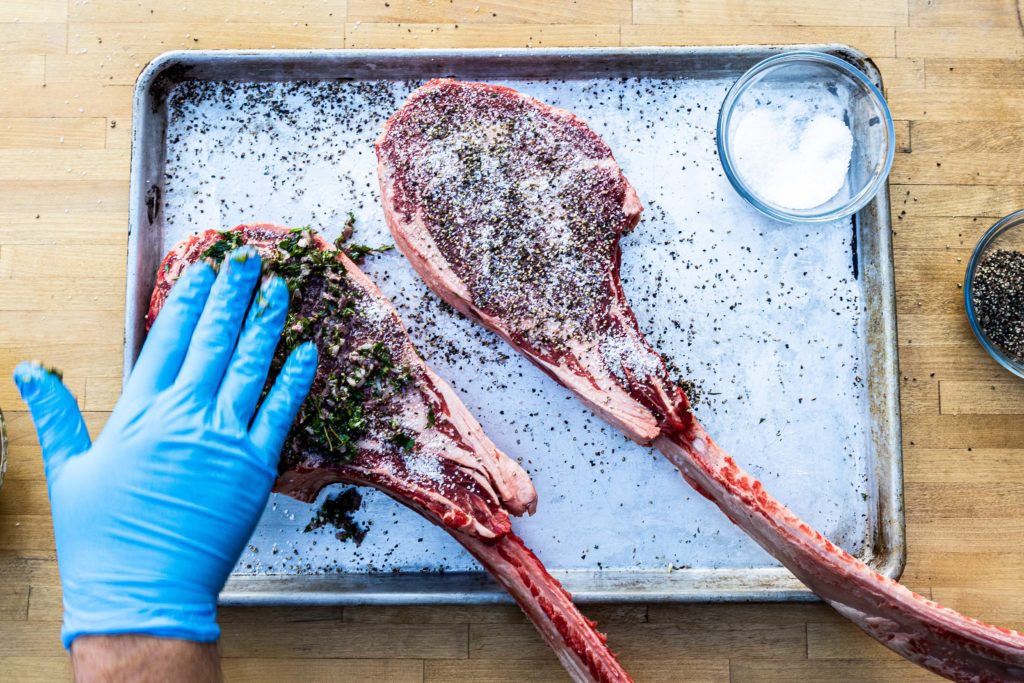
What cut is a tomahawk steak?
The tomahawk—also called the cowboy ribeye or cowboy steak—is a large bone-in rib-eye steak cut from between the 6th and 12th ribs of the cow and usually weighs between 30 and 45 ounces. The bone in these bone-in steaks is not like the standard bone-in steak bone. It’s a foot or more longer than the steak it is attached to. The steak gets its name from its loose resemblance to a throwing axe with a bone handle.
Because it is essentially a ribeye, the meat is usually tender and well-marbled, which is great because there’s something special about the flavor and smell of cooked ribeye fat. It’s a true crowdpleaser for its rich flavor and juiciness. Also, the steak’s frenched bone makes a very impressive presentation. (Frenching is the process of scraping rib-bones clean so they look nice when cooked.)
Is a tomahawk steak worth the price?
In the end, a tomahawk steak is just a large, bone-in ribeye with a lot of extra bone weight attached to it. Whether you buy your tomahawk to cook at home or buy it at a restaurant, that means you’re paying ribeye-steak price for something you aren’t going to eat—and since restaurant markup for ingredients is 300%, that means a lot of extra money for, in essence, an amazing presentation. If you’re going to eat one of these meat hunks, which are delicious, do it at home!
But if the photo-op/presentation doesn’t matter to you, just get a thick-cut ribeye.
What is the best way to cook a tomahawk steak?
Right up front, the best way to cook a large cut of steak like the tomahawk is to use the reverse-sear method. With a steak that is over two inches thick, thermal considerations come heavily into play. For the reverse sear, first cook the steak over indirect, lower heat. Cooking the steak in a grill that is only 250°F (121°C) will heat the inside of the steak very evenly, giving us more chance at an edge-to-edge pink finish.
Ultra-thick Flintstones-sized double-cut bone-in big-enough-to-serve-two-fully-grown-Thundercats rib-eye steaks require a bit of extra care when cooking. Their thickness makes it all too easy to end up with a burnt exterior and a cold, raw middle… A prewarmed steak will sear much faster, minimizing the amount of overcooked meat under the surface.
The Food Lab, Kenji Lopez-Alt
A Smoke™ is perfect for this part of the cook, as you can monitor both the indirect-heat temperature and the internal temperature of the meat.
Once your steak reaches a temperature about 20°F (11°C) below your desired doneness, you’ll want to get your sear going! Heat your grill to high and sear the steak to give it a tempting, tasty crust. Sear it until the crust looks perfect and the internal temp is about 5°F (3°C) below your desired finish temp.
And that brings us to another thermal consideration: carryover cooking. For thinner steaks, carryover is a smaller concern, as there is less thermal mass. But with a steak this large, carryover is going to matter more. This is one reason why using a thermometer matters. If, by some chance, you could accurately tell if a steak were done by touch, telling if it’s going to be done after carryover is a bit trickier.
And since you’ve spent all that moolah on meat you should do your best to cook it right, and remember that heat transfer and the careful monitoring of internal temperatures are at the core of a perfect cook. As Kenji says,
…buy a digital instant-read thermometer. You will never over- or undercook a piece of meat again. Do it. No more excuses, no more timing charts or poking with your fingers. Just buy a good thermometer, and don’t look back. I guarantee you will not regret it.
The Food Lab, Kenji Lopez-Alt
A Thermapen®® Mk4 is perfect for dealing with the sear. It reads fast, in 2–3 seconds, so you don’t have to put your hand over the high heat for long, and it’s accurate to 0.7°F (0.4°C), so you know that you’re getting a true reading. No finger-pressing necessary.
Steak doneness chart:
| Rare | Medium rare | Medium | Medium well | Well | |
|---|---|---|---|---|---|
| Pull temp | 115–125°F | 125–130°F | 130–140°F | 140–150°F | 155°F and up |
| Final temp | 120–130°F | 130–135°F | 135–145°F | 145–155°F | 155°F and up |
A note on those bones…
The stark-white bone is part of the fun presentation, and we want to make sure it shines. To prevent your bones from charring or getting all smokey, wrap them in foil before you cook them. They’ll come out looking much nicer for that brag-photo you’ll send your friends later.
How to cook a tomahawk steak
With temperature advice from The Food Lab, by J. Kenji López-Alt
Ingredients
- 2 Tomahawk Steaks
- Salt and pepper
- Fresh herbs, olive oil, garlic (optional)
Instructions
- Set up your grill for indirect cooking. In our case, this meant staring a low fire in a kamado-style cooker with the diffuser plate in place and shutting the vents down pretty far.
- Place the air probe of your Smoke in the grill (following proper probe safety procedures) and set the high-temp alarm to 275°F (135°C) and the low-temp alarm to 200°F (93°C). Once your grill settles down within that range, you’re ready to cook.
- Prepare the ribeyes by salting them, peppering them, and rubbing them with a mixture of olive oil and finely minced herbs and garlic.
- Wrap the bones of the steaks in foil to protect them from burning.
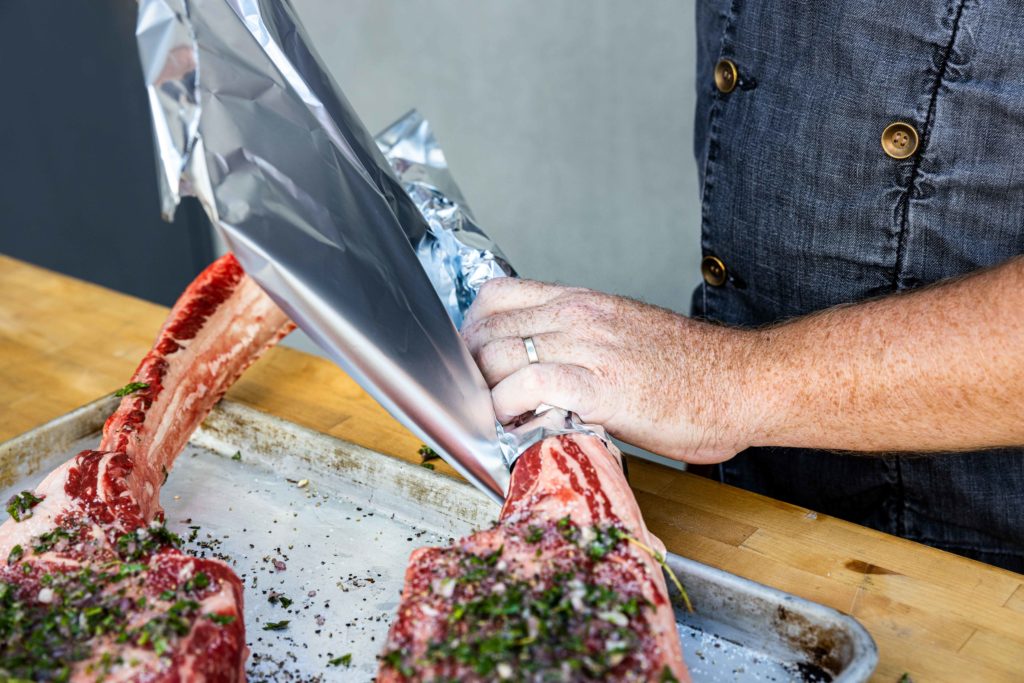
- Place the steaks on your preheated, indirect-cooking grill. Insert the Smoke’s meat probe into one of the steaks and set the high-temp alarm for 100–110°F (38–43°C) for rare/medium-rare steaks.
- When the alarm sounds on your smoke, verify the temperature with a Thermapen.
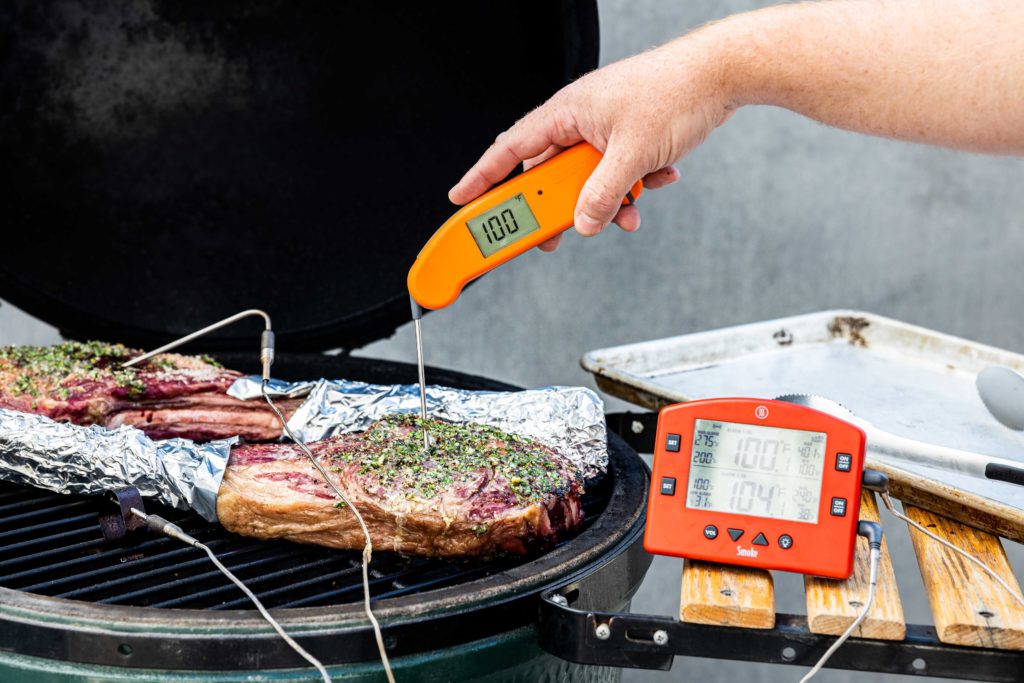
- Remove the steaks and the air probe from the grill and increase your grill’s heat to high. (For us, that meant taking out the diffuser plate and letting lots of air in.)
- Remove the probe from the steaks as well, and place the steaks back on the hot grill and cook to sear them.
- Cook the first side for 2–3 minutes, then flip and cook the second side for a few minutes also. Start checking the internal temp with a Thermapen® somewhat regularly to make sure you don’t overshoot your target pull temp.
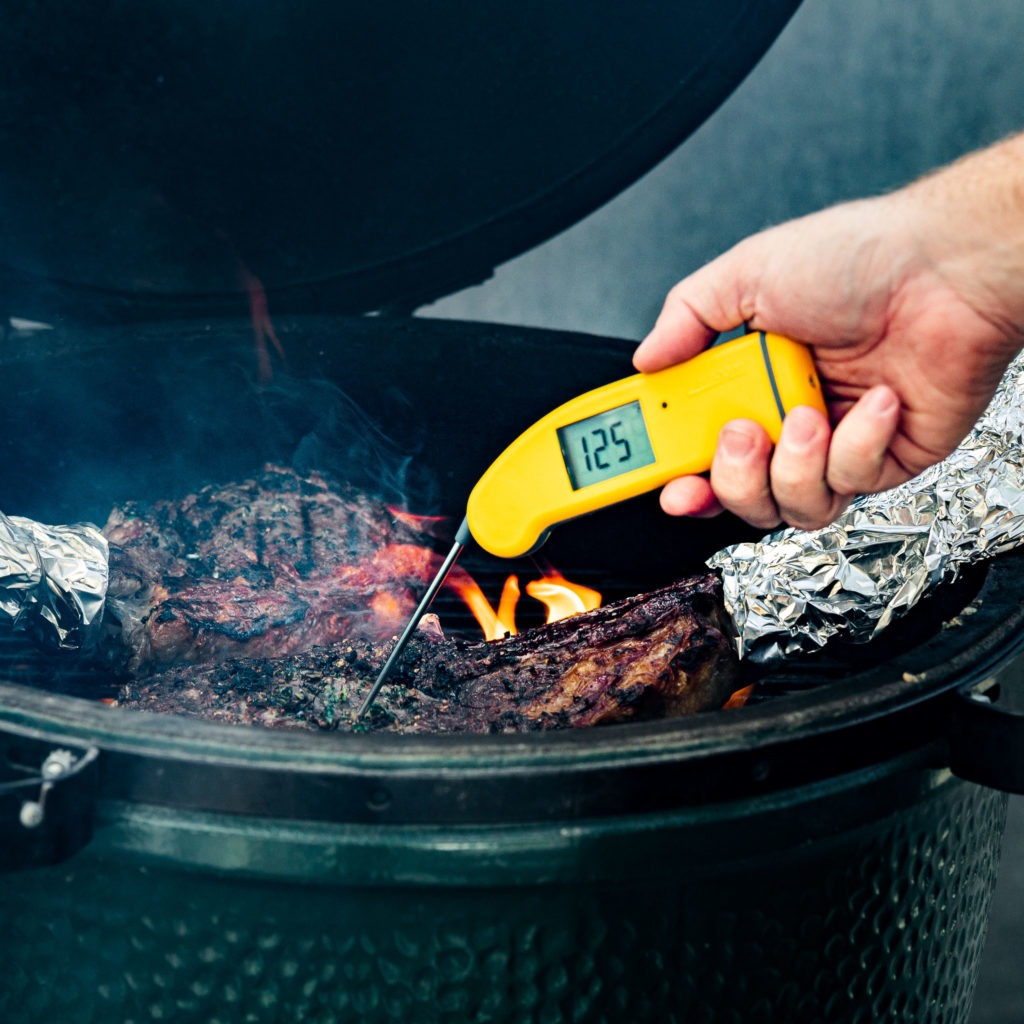
- Pull the steaks from the grill when the internal temperature reaches 125°F (52°C) (for a final medium-rare temperature of 130°F [54°C]), and allow to rest for 5 minutes before slicing and serving.
- Eat up.
When these steaks come to the table, you can bet there will be ooh-ing and awww-ing and reaching for phone cameras—not to mention one or two caveman jokes. But if you’ve been thermally-minded throughout your cook, what there won’t be is complaints about how the steak is cooked. These thick tomahawk steaks need a two-stage cooking process in specific temperature zones and temperature monitoring with a leave-in thermometer and an instant-read thermometer for them to finish just right, and if you give them what they need, the payoff will be, quite literally, huge.


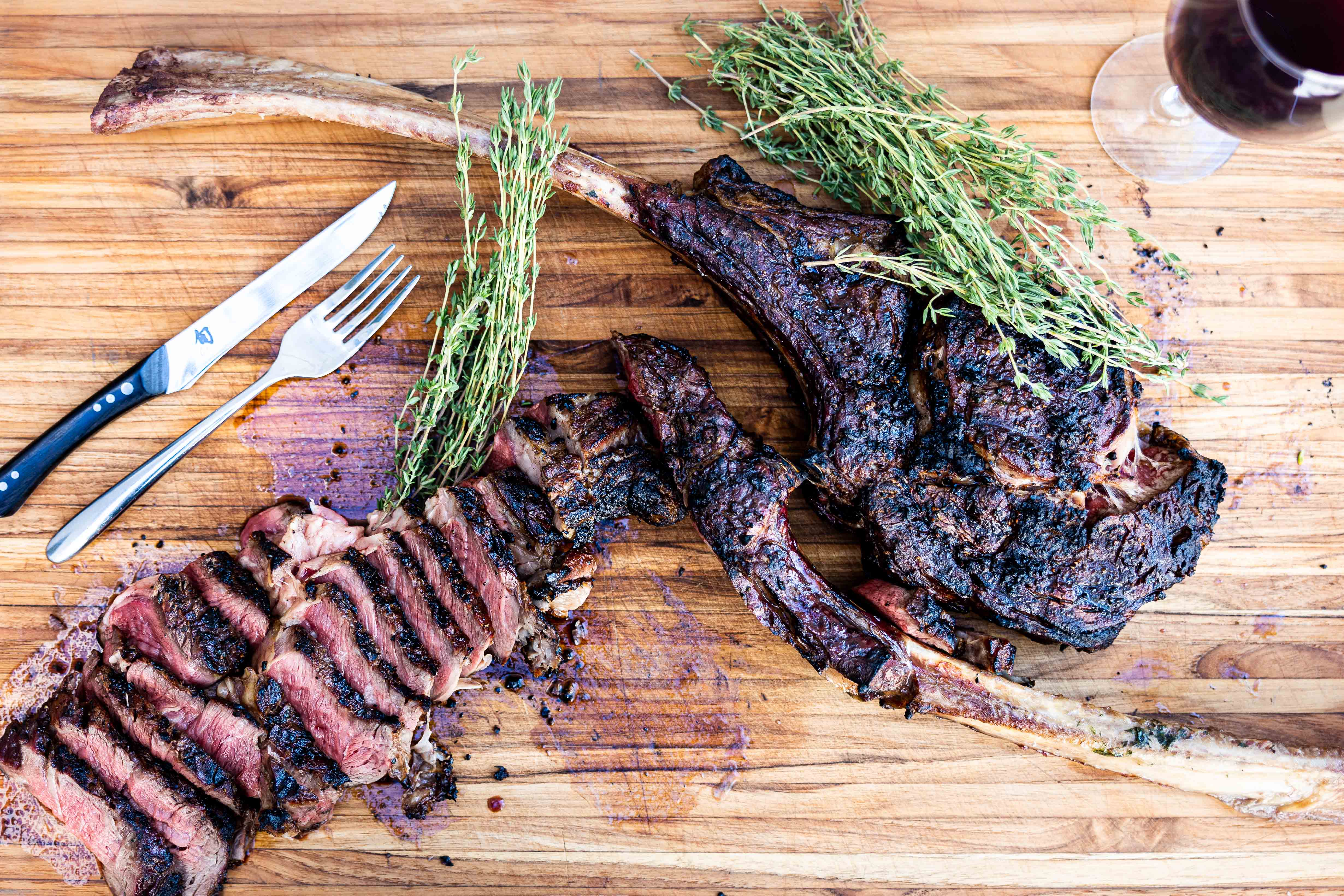
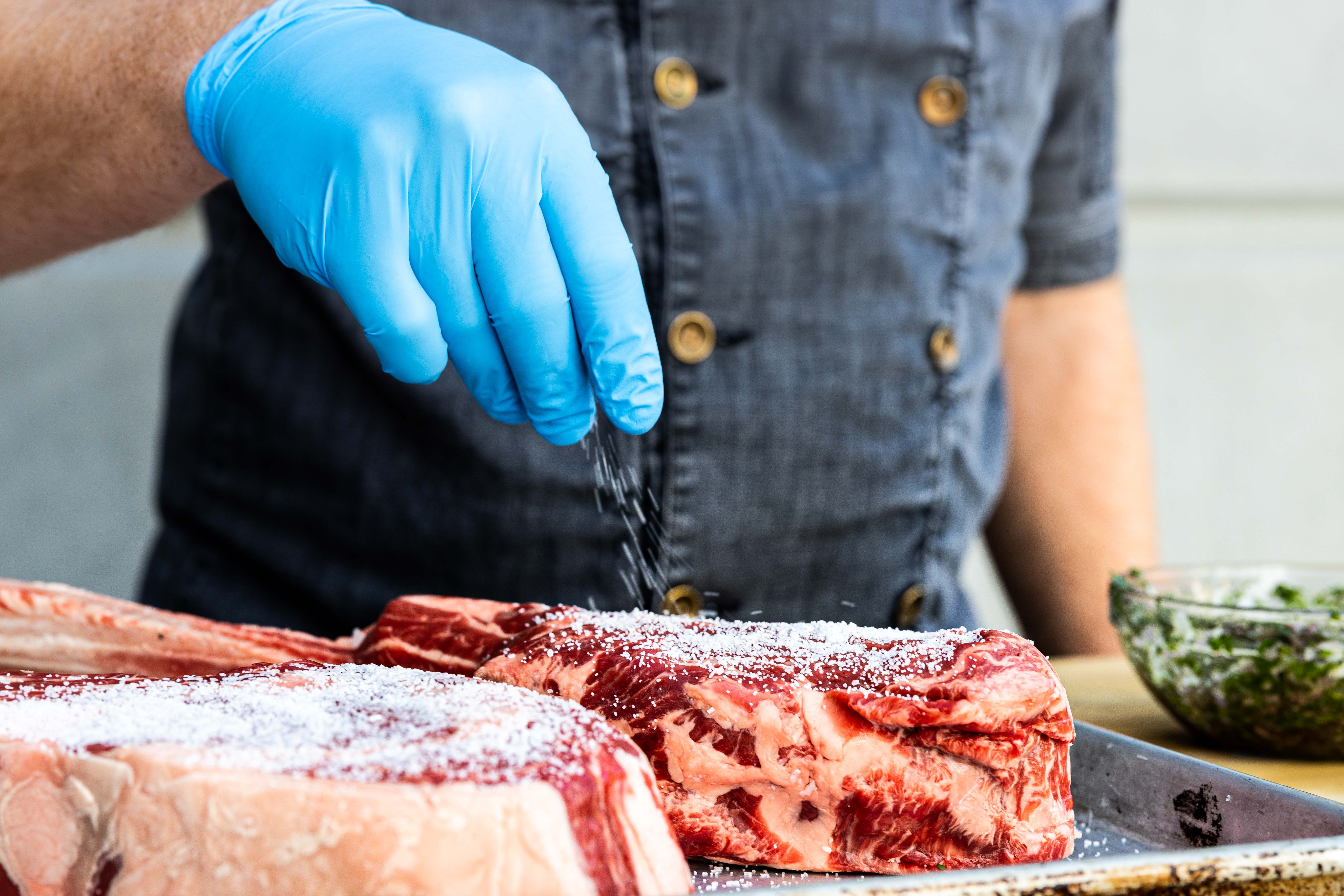
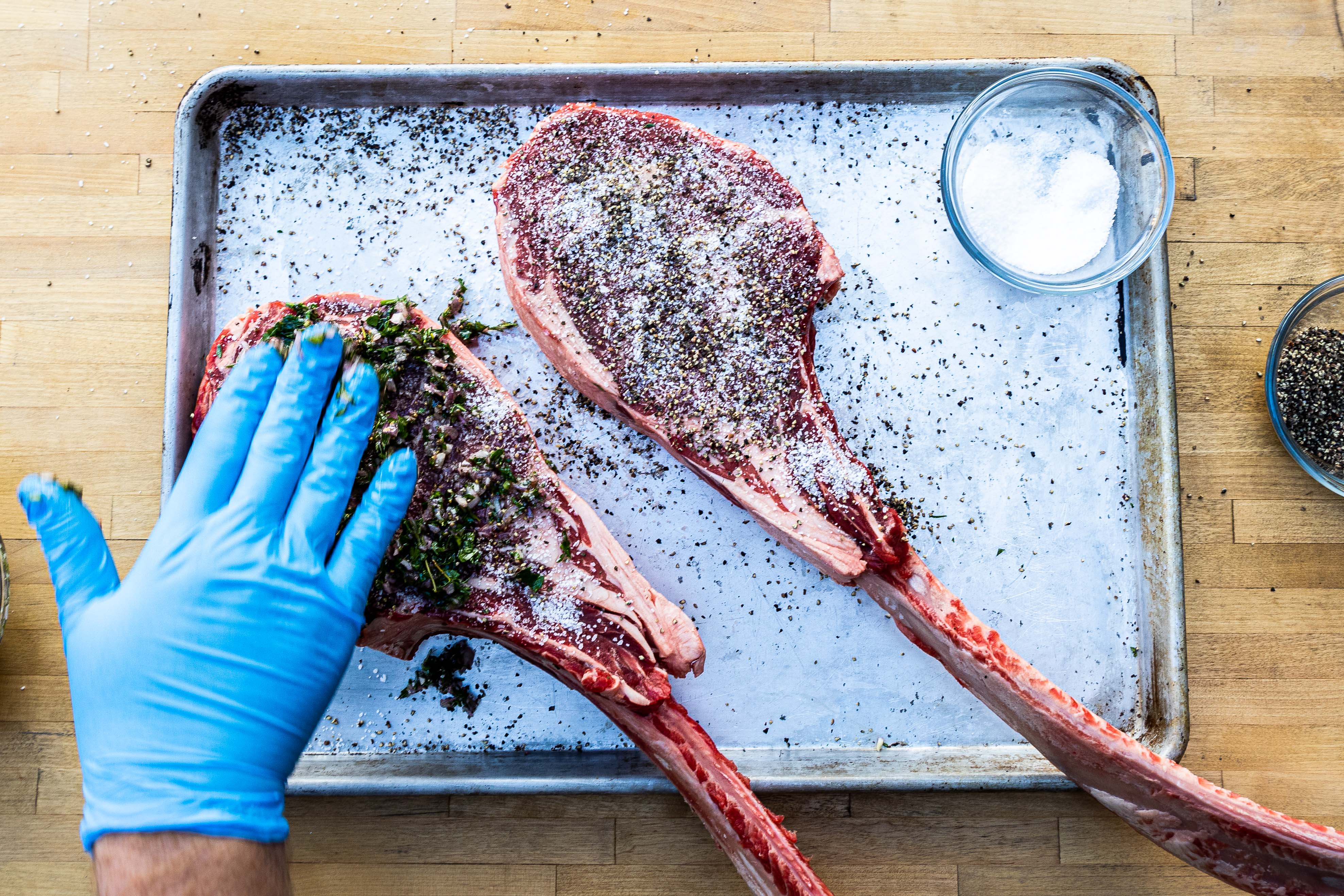
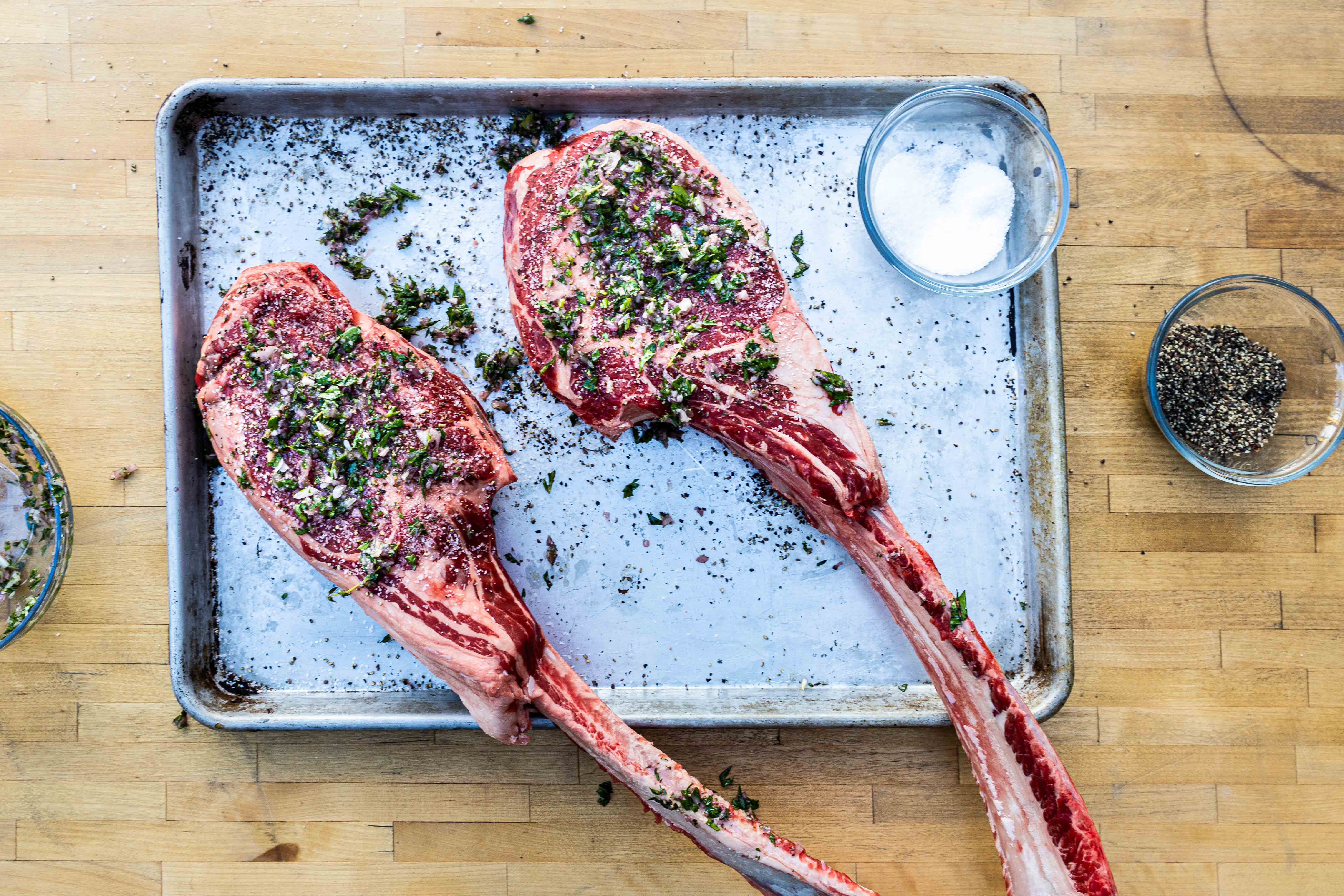
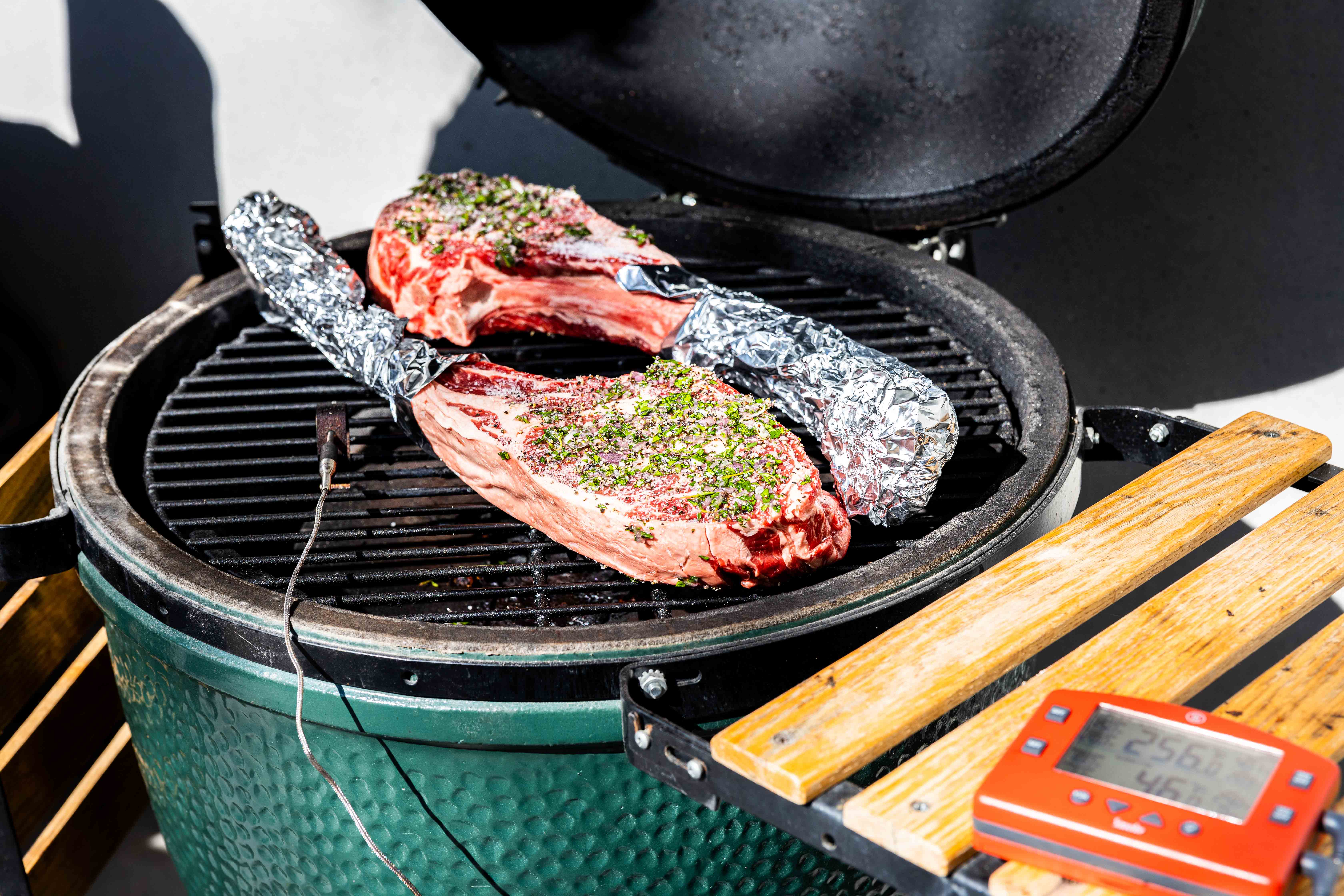
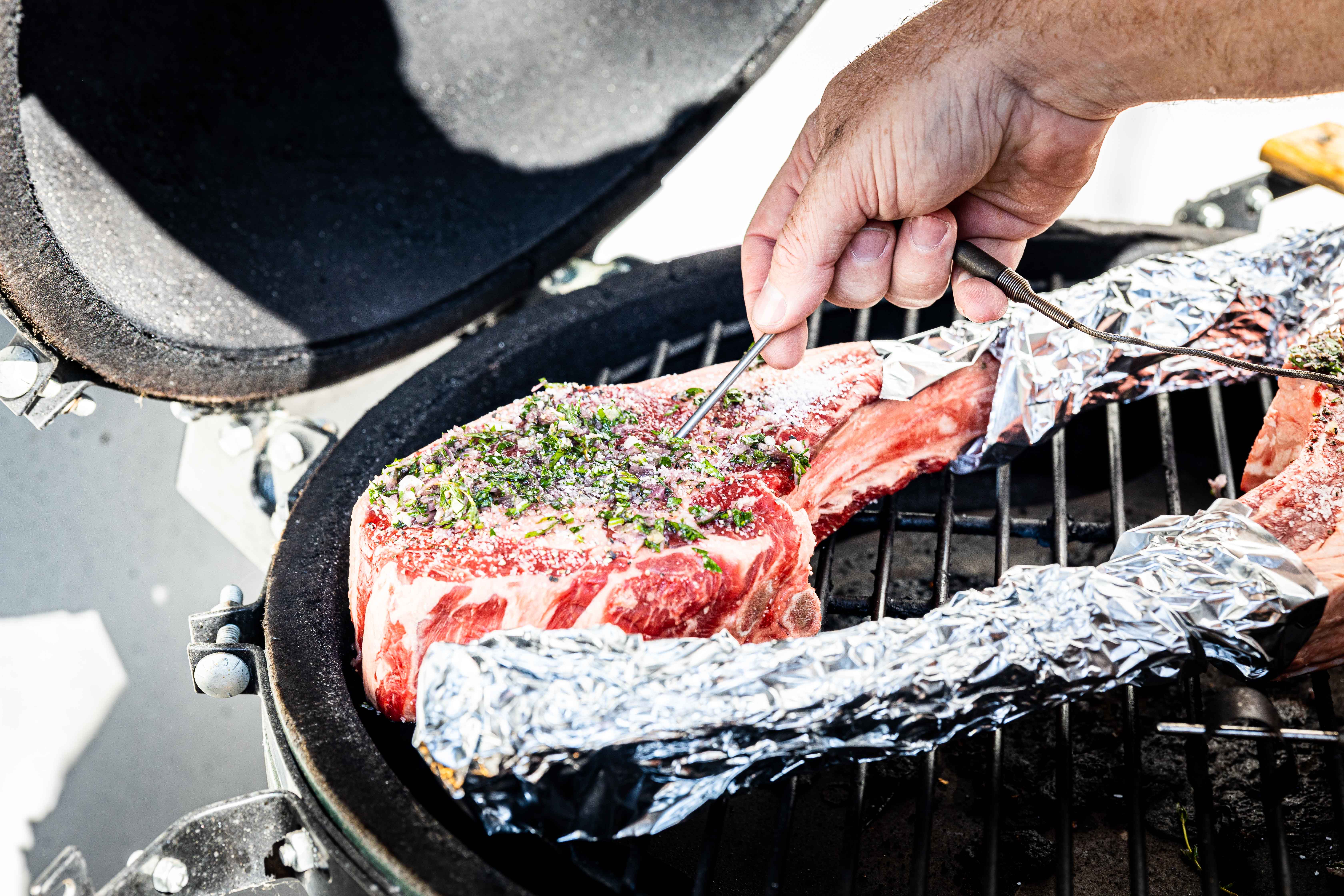
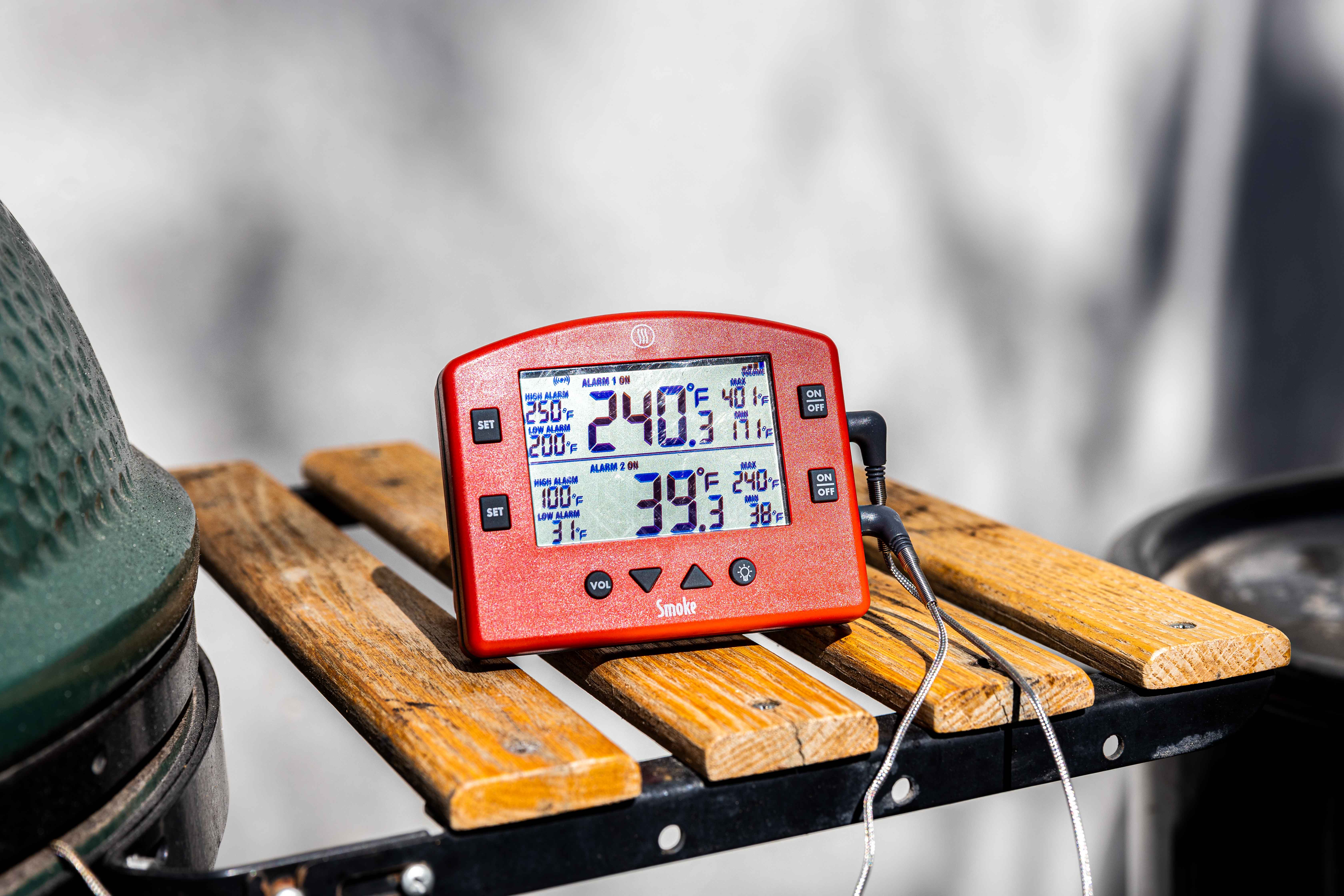
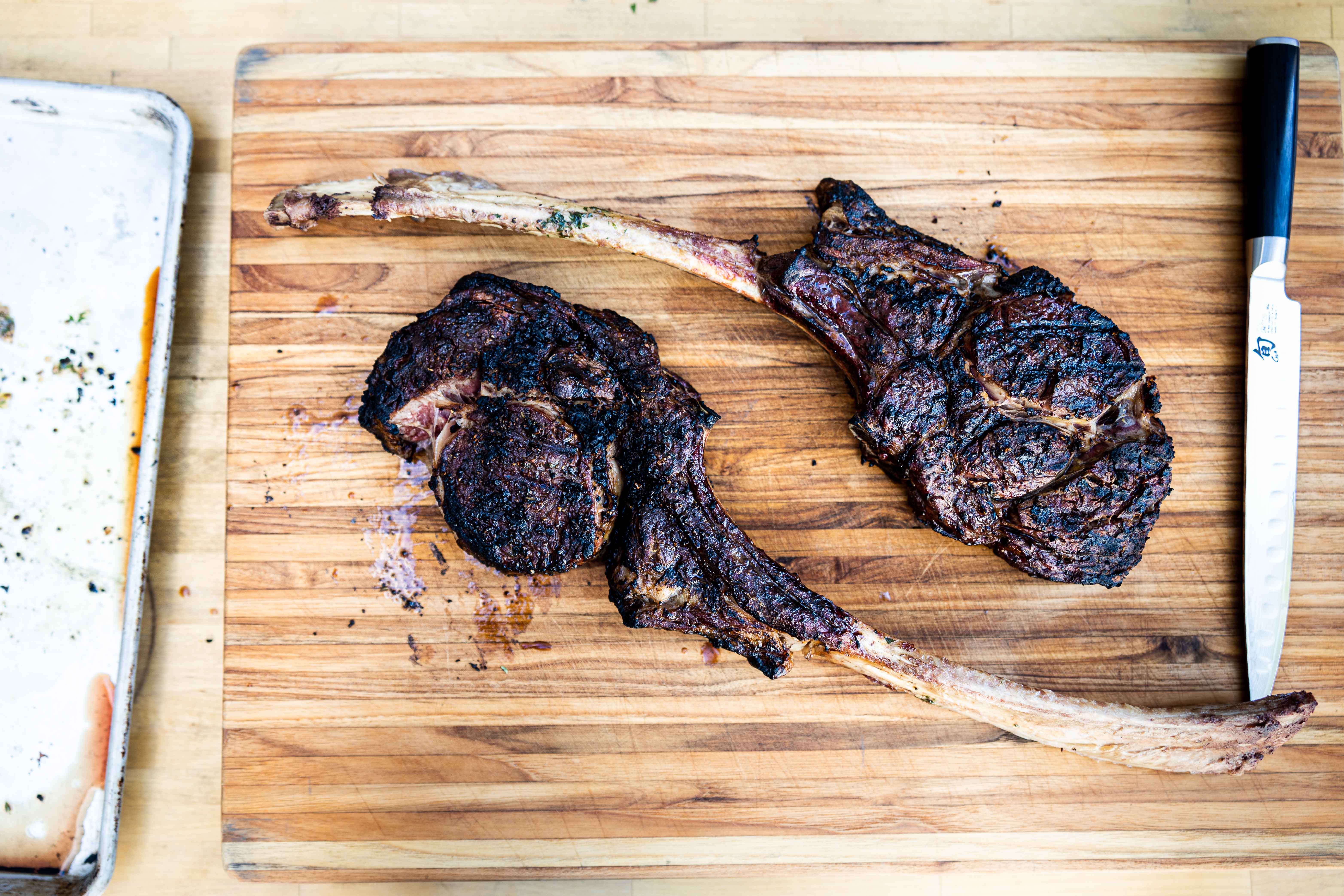
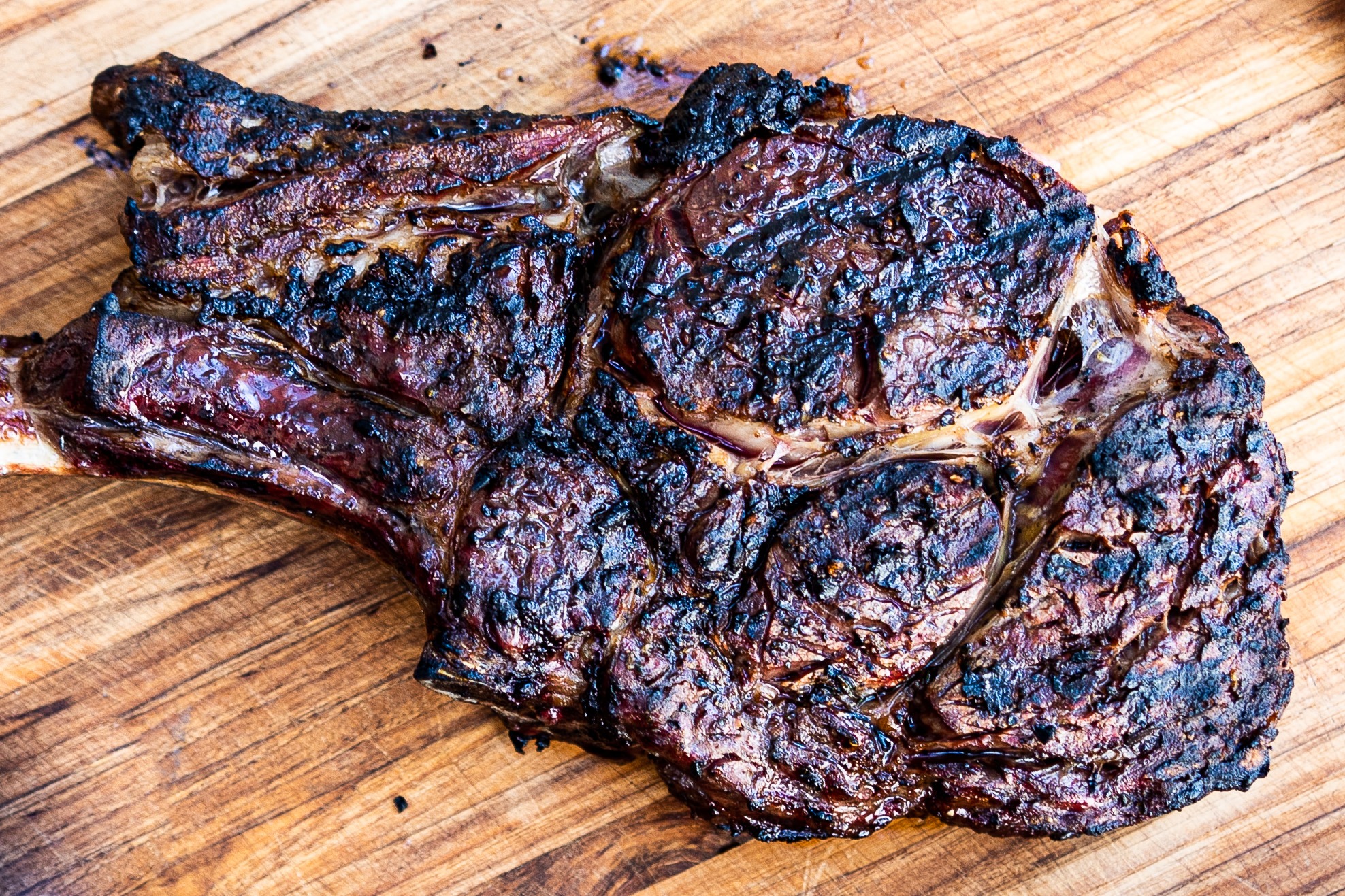
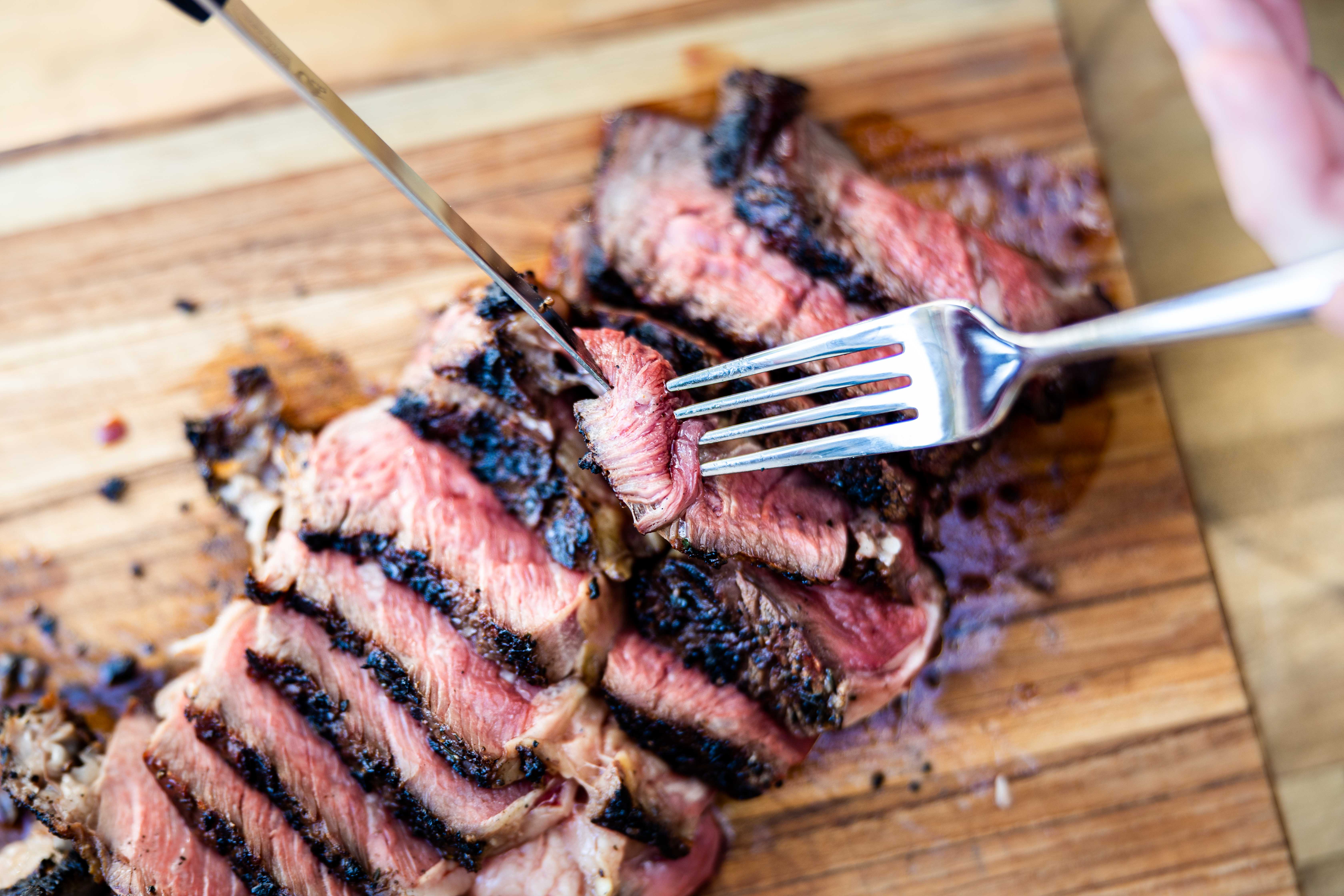
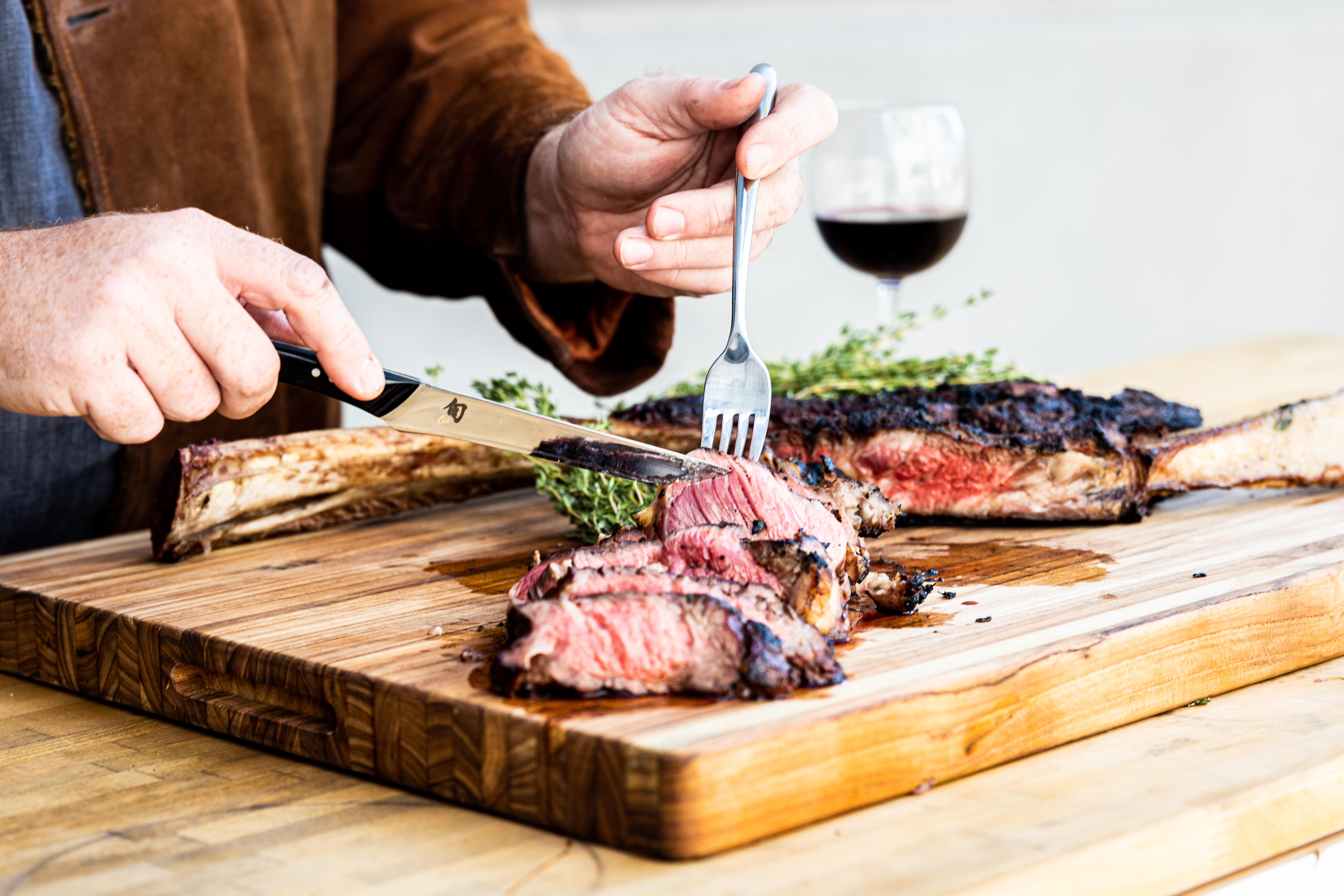
Since the Pit Barrel cooker is designed to be set up once, initially, to maintain a temp of, I believe, approximately 279 degrees F, and incremental adjustments are difficult, how is one to achieve and maintain a temp range of 225 to 250? Fiddling with the one adjustable vent is time consuming (for the slow response) and very hit and miss. Have you come up with an easy and reliable method?
Barb,
Thank you for your comment! there is a little bit of a learning curve with each grill and smoker. We’ve been testing how much charcoal is needed to reach those temps rather than relying on the adjustable vent. About 1/2 of a chimney full of charcoal does the trick for us to reach that temperature range. We have been impressed with our Pit Barrel Cooker’s results.
Thanks!
-Kim
You can do it with ease using a traeger smoker
That’s a lot of hoops to jump through. Why not sous vide the steak to the desired temp. and then sear and gorge? No muss-No fuss.
Randall,
Sous vide is another awesome two-stage method! Sous vide is phenomenal to get perfect results every time. Thanks for your comment!
-Kim
Problem with sous vide is if you don’t get the water temperature right you’ll end up rendering the fat if you don’t get it right. Stick with the reverse sear approach, it’s much more manageable.
Brendan,
Fully rendering the fat from inside the fat cells will take temperatures that are not common in sous vide. If you have a reliable sous vide circulator, then it’s a pretty safe bet that you can nail the temps.
Indirect cooking with charcoal allows smoking the meat during the indirect cook. For fatty meats and fish this is extra awesome as the smoke penetrates very quickly. I have settled on cherry wood after trying a lot of different options. My Weber tends to run closer to 350 degrees but I can use it to get an incredible cowboy steak: dry rub 24-48 hours ahead, cook indirect with several cherry wood chunks on the fire for about 20 minutes, turning once. When the internal temp is 115 degrees, reverse sear for just a couple minutes on each side. Much shorter cook time than with a 250 degree running temp, but my cowboy steaks are pink from edge to edge, smoky, juicy, addicting.
Temperature control is a must! In it to win it for dat thermopen 🙂
Curtis,
The Thermapen really is an amazing tool. Hopefully you’ll be one of our ThermoMonday winners!
-Kim
OK, Kim, you are a lifesaver! At least saving the life of a Tomahawk Steak. As luck would have it I ordered 4 from SRF last month for delivery this Friday and received your email on the 11th. WOW the timing! However I was perplex as to how you got the temp of the PBC down to 225 range as it doesn’t take well to adjustments. So I went to Amazing Ribs Pit Forum and got a lot of good suggestions, but didn’t really answer my question. I even called Noah at PBC yesterday to seek his advice. While we talked about reverse searing, he was of the opinion that 270 was OK and to cook each side for a few minutes (7-9 minutes each) and it would be ready. Well I decided that that wouldn’t be a reverse sear and I wasn’t about to experiment with a steak of this magnitude and cost. So I made the decision to go with my Weber and SnS. Then I read this post’s comments today; 1/2 chimney full, incredible! I will pass this on to the Pit Forum as well. BTW I own two Thermapens and even bought one for my son the Chef. You guys rock, along with SRF and Pit Barrel Cooker. Thank you. Doc
Dr. Howard,
I’m so glad our tomahawk post was published just in time for you! I can understand wanting to get your cook just right when you buy such high quality protein. Temperature control is definitely a must to get the tomahawks just right——keep your eye on the internal temperature during both the smoking and searing. Let us know how they turn out!
Thanks,
-Kim
Hello,
Just wandering, is the 1st stage, at low heat, direct or indirect?
Should i use heat deflector stone? And should the steaks be flipped, at least once?
THank you.
Pete
P.S. Love my Thermapen and everyone loves my results.
Pete,
In the first part of the cook the steaks were smoked on the grate of a pit barrel cooker at low heat (225-250°F). During this stage of the cook the steaks were not flipped at all.
Thanks!
-Kim
A ribeye steak by definition is a boneless steak. If it has a bone it’s a rib steak
As far as I am concerned, ANY rib chop, beef, pork or even lamb (although not so much for this critter) is RUINED when all that delicious meat along the rib bone is removed 🙁 What a crime to strip it away just for the sake of appearance!
The best food in my world is a standing rib roast coming out of my KBQ C-60. I can run it low and slow and finish up with the reverse sear by cranking up the heat. No grill required.
Folks, if you cant get your BBQ down to 225F then use the oven for the first part of the cook. But I would highly suggest a pellet smoker, it will change your life! but an oven will do in a pinch, or sous vide is also a viable option.
i just received my MK4 and i being left handed thought from your statements that it could
be used in a left or right hand and yes it does except when using in the left hand the pin needs to be fully extended and used upside down and all photos you show it being used in the right hand and at an angle. i do perfer to use it at an angle opps cant do that. i still really like the MK4
Hello
What herbs do you suggest for grilling the tomahawk ribeyes?
Thx
T
Ooh! Parsley, thyme, and maybe a little rosemary. If you want to put a Mexican spin on it, some cilantro, lime zest, and fresh garlic would be nice.
I have never understood why a Tomahawk is better than a regular bone-in ribeye. It looks cool, and is a lot more expensive, but doesn’t it taste the same? Also hard to find a sous vide bag that will fit it.
It’w really just…aesthetics. It’s so cool looking and fun! But, yes, you’re paying for a lot of bone weight you aren’t going to eat.